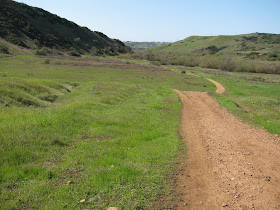I have walked Rancho Santa Maria de los Penasquitos just a couple miles south of my house many times since coming to San Diego, but I had to check it out again this week after the Union Tribune reported the Easter Sunday earthquake caused the artesian well to more than double its output. More on that later.
The canyon preserve is an idyllic six mile walk end to end through one of the largest urban parks in the US, about 4000 acres in all.

I have walked here with coyotes in early morning, watched the hawks on the hillside, given wide berth to snakes. When I first started walking the canyon twenty years ago, I could feel completely away from civilization. These days housing developments have been allowed on the ridge line.

A stream flows east to west across the canyon, crossing midway through rock cliffs (Penasquitos means "little cliffs") with a substantial waterfall in springtime.

I wasn't able to climb around for a picture of the falls, but there were other points of interest in my viewfinder.

You're walking a lot of history across this beautiful little canyon. The eastern part of the canyon was part of the first San Diego land grant, made by the governor of Mexico to the comandante of the Presidio, Captain Francisco Maria Ruiz, in 1823, one league in all (4439 acres), now the burg of Rancho Penasquitos. Before the Captain's grant, the land was used by the Mission padres for sheepfarming and orchards, and before them by Kumeyaay Indians going back 7000 years. Captain Ruiz asked for additional land and in 1834 he was given another league that extends westward almost to the I-5 and is most of our canyon.
The Captain was already in his 60's when he got this original land grant. He had a house in Old Town near the Presidio, but built a one room adobe house on the eastern end of the preserve for his visits to the ranch. When he died in 1839, the bachelor Captain passed the rancho to his grandnephew, Francisco Maria Alvarado, who lived both in Old Town and at the rancho with his family.
Francisco gave all his land to his son, Diego, who took over ranch operations in 1857 and built his house and ranch buildings at the western end of the canyon. Some ruins still stand but are enclosed by chain link making a good photo impossible. When I can resurrect one of my photos of the ruins from 20 years ago I will post as an addendum.
Francisco's beautiful daughter and Diego's sister, Estafana, married George Alonzo Johnson, a gringo from New York City. Read here for a fascinating personal account of Mr. Johnson's adventures before he met Estafana. After marrying Estafana, the couple bought property from Diego in the eastern end of the canyon to build their adobe, a wonderful house with veranda facing west across the canyon. What a view! Too bad the inheritance practices in those days gave all the land to the male heir, and Estafana had to buy her father's land back from Diego.
Three walls of the original adobe were incorporated into the new house, and the Johnson-Alvarado is the one standing today.

The front porch,

and back veranda facing the sunset.

Other history lives here in the canyon. The main road from Old Town San Diego to Yuma went through the canyon in the early to mid-1800's. In mid-December 1846 the 300 Army of the West soldiers surviving the Battle of San Pasqual were led through the canyon by General Kearny on their way to San Diego. Our guy, Mr. Johnson, fell on some hard financial times and the canyon was bought in 1880 by Colonel Jacob Shell Taylor, founder of Del Mar, who was going to sell it as subdivisions for development! Lucky for us, the bust of the late 1880's when the transcontinental rail failed to materialize for San Diego squashed that plan and the canyon continued as a working ranch for many decades, as late as the 1960's.
Back to the reason for this week's trek to the canyon, the artesian well just to the side of the Johnson-Alvarado adobe, inside this shelter.

The day after the Mexacali earthquake last month, water volume doubled from the well, likely from new fractures in the rock mass just below the ground.

A few more earthquakes like that and I could have my own personal hot springs right here in Del Mar.
Look forward to the 20 year old photo as addendum. And that water looks so clear - can you get in?
ReplyDeleteNo, it's walled off, but the water temperature is 70 degrees. Not quite a hot spring, but a good source of drinking water for the ranchers. Must be very tasty.
ReplyDeleteI just found this blog. It is great. Taylor was my great great grandfather on my dads side. My husband and i visited about three years ago and it is beautiful.
ReplyDeleteKelly Mackay Cannon
Kelly, I am so pleased to hear from a living person connected to the Canyon. I hope I accurately put all the history together.
ReplyDelete